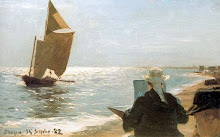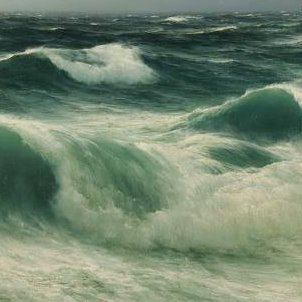HMS Bellona. An English man-o'-war of Nelson's Era, by Geoff Hunt. Appears on the cover of Patrick O'Brian's book "The Yellow Admiral".
There's a marvellous feeling of space in this work, by the English marine painter Geoff Hunt, due to the use of increasingly desaturated tones with distance. On the nearest ship we can see a slight obscuring of the bow in comparison with the stern.
in the work below, the more distant vessels have almost disappeared in the dense atmosphere of driving rain.
Both painters have opted for a composition based on three vessels, with the added interest of a different object - a rowboat - linked to the largest vessel. A trinity is more visually appealing than a duality. Generally, odd numbers are better than even.















































